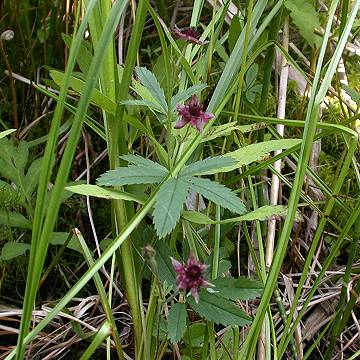

Potentilla palustris - (image 1 of 5)
Taxonomy
Family: Rosaceae
Habitat
Typical habitat is bogs. Also swamps and stream banks
Associates
Carex trisperma, Chaemaedaphne calycuta angustifolia, Drosera rotundifolia, Dulichium arundinaceum, Hypericum virginicum, Larix laricina, Lysimachia thrysiflora, Menyanthes trifoliata minor, Osmunda regalis spectabilis, Sarracenia purpurea, Thelypteris palustris. In more open areas with Eupatorium perfoliatum, Iris virginica shrevei, Polygonum amphibium stipulaceum, Sagittaria latifolia, Scirpus acutus, Typha latifolia, Vaccinium macrocarpon.
Distribution
Circumboreal, south to NJ, Ontario, IA, and CA.
Morphology
Slender, herbaceous perennial. Leaves alternate, pinnate compound; leaflet mostly 5, oblong, over twice as long as wide, toothed; stems glabrous below. Flowers deep red-purple; petals and sepals 5; the sepals pointed, wider and longer than the petals.
Notes
Flowers early June to late July
Wetland indicator: Obligate
A European strain of this species and Fragaria x ananassa are the parents of the magenta flowered Fragaria x 'Lipstick'. Linnaeus called this plant Comarum palustre and this is the name the USDA is currently using.
References
Gleason, Henry A. and A. Cronquist. 1991. Manual of Vascular Plants of Northeastern United States and Adjacent Canada. Second Ed.
The New York Botanical Garden. Bronx, NY.
Peterson, R. T. and M. McKenney. 1996. A Field Guide to Wildflowers:
Northeastern and North-Central North America.
Houghton Mifflin Company. Boston, MA
Swink, F. and G. Wilhelm. 1994. Plants of the Chicago Region.
Indiana Academy of Science. The Morton Arboretum. Lisle, Illinois.
USDA, NRCS. 2002.
The PLANTS Database, Version 3.5 (http://plants.usda.gov).
National Plant Data Center, Baton Rouge, LA 70874-4490 USA.
|
Michael Hough © 2005 |